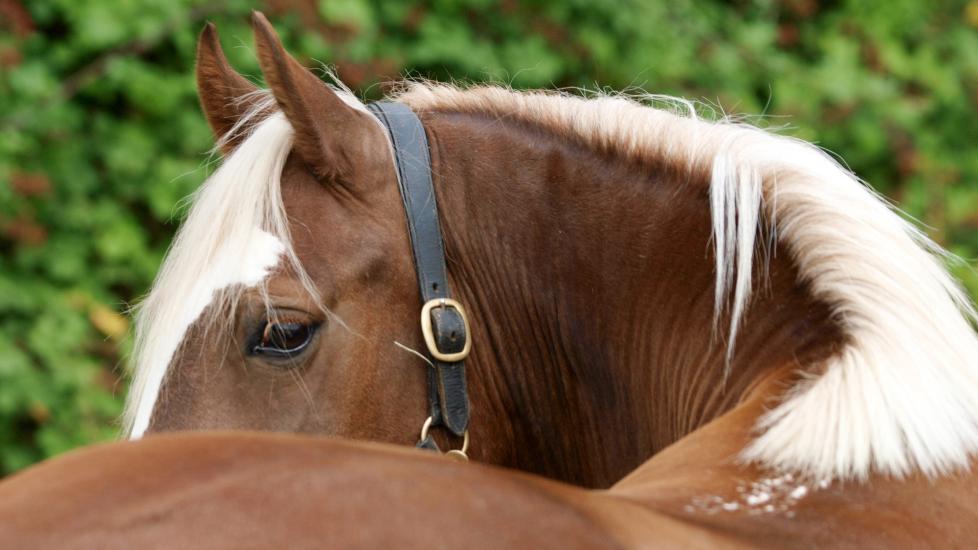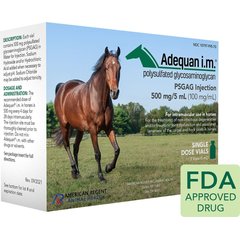Kissing Spine in Horses
What Is Kissing Spine in Horses?
Kissing spine in horses refers to the tops of the vertebrae along a horse’s back touching and rubbing together in typically a painful manner. This condition is also referred to as overriding dorsal spinous processes or ORDSP.
Kissing spine is the most common cause of back pain in horses and is likely present in up to 40% of all horses. However, most of these horses do not show clinical signs of pain so it is often underdiagnosed. Horses most likely to experience noticeable discomfort from kissing spine include:
-
Thoroughbreds
-
Performance or dressage horses
-
Horses less than 5 years old
-
Horses with advanced disease (more than five vertebrae involved)
Symptoms of Kissing Spine in Horses
Symptoms of kissing spine in horses can be vague, but may include:
-
Back pain, particularly when under saddle or being ridden
-
Overly sensitive to the touch along the back, even with brushing/grooming
-
“Girthiness” (reactive to tightening of the girth/fastening the saddle)
-
Hollowing or arching of the back
-
Bucking or kicking
-
Generalized lameness
-
Cross-cantering
-
Refusing or approaching obstacles incorrectly
-
Overall poor performance
Most horses with kissing spines luckily do not show clinical signs. The more severe the overlapping or the rubbing of the spinal deformity or the higher performance/workload of the horse, the worse the signs of discomfort may become.
Causes of Kissing Spine in Horses
The development of kissing spine is still somewhat of a mystery. While no genetic factors have been definitively identified, there is a possibility there are genes that predispose some horses to this condition. Other potential causes of kissing spine in horses include:
-
Poor conformation, or physical structure and shape of the horse’s back.
-
Improper use of muscles—Lack of engagement of abdominal muscles under saddle leads to a hollow or saggy back that allows the spinal bones to venture closer together.
-
Poor saddle fit that leads to excessive pressure over the more sensitive spinal bones.
-
Prolonged or repeat trauma and inflammation in these areas causes bony changes and growth of the vertebrae.
Most affected vertebrae are seen along the withers where the curve of the spine changes, although some kissing spines are seen in the lumbar region (further down along the back). The number of vertebrae impacted vary, but horses can have two to sometimes more than five vertebrae involved. These can be consecutive all together, or there may be “groups” of overlapping vertebrae.
How Veterinarians Diagnose Kissing Spine in Horses
If your horse has been acting out under saddle, your veterinarian will first start with a full physical exam and lameness evaluation. They will go over the whole body, looking for overt sensitivities or flinching along certain areas. If the back is painful to the touch either over the vertebrae or along the connecting muscles, your veterinarian may recommend further diagnostics which could include:
-
Thermography—Thermal imaging can show heat distribution through the horse’s body. Thermography for kissing spine usually reveals one of three patterns: a “hot streak,” a “cold streak,” or a combination over the back. Thermography has been beneficial in determining if kissing spine or another issue is the primary cause of back pain in horses.
-
Radiographs—To date, radiographs (X-rays) are still the primary method for evaluation of kissing spine in horses. These can be performed in the field or clinic setting and indicate a definitive cause of the back pain.
-
Nuclear bone scan—Nuclear imaging involves the use of small amounts of radioactive material and a special camera to see structures within the body.
-
Ultrasound—High-frequency sound waves can be used to make an image of the horse’s internal body structures.
Treatment of Kissing Spine in Horses
Potential medical treatments for kissing spine in horses include:
-
SME (shockwave, mesotherapy, exercise) therapy:
-
Shockwave involves the use of short, focused pulses of sound waves that encourage healing in connective tissues, muscles, and ligaments.
-
Mesotherapy focuses on the middle layer of skin that sends pain signals to the spinal cord. Steroids or other medications may be injected with these multi-pronged needles.
-
Exercise—The Pessoa® Lunging System may be used to encourage the proper use of core muscles.
-
Other methods like carrot stretching to engage the side, abdominal and neck muscles are also beneficial.
-
Encouraging proper use of the back and abdominal muscles to prevent a “hollow” back will appropriately strengthen a horse’s back muscles and prevent improper rubbing of the dorsal vertebrae.
-
Moving in a relaxed frame is important to discourage improper tension of the back muscles.
-
Ground pole exercises can later engage the proper muscles under movement to create strong abdominal and back muscles and form.
-
Treadmill or water exercises may also be recommended to create positive movement with minimal weight on the joints.
-
-
-
Muscle relaxation medications such as methocarbamol, or NSAIDs may be prescribed to reduce tension of the muscles along the spine and minimize discomfort.
-
Injections—Some injection methods include mesotherapy alone as described above, or injection of steroids, joint products, or orthobiologics into affected joint spaces using ultrasound guidance.
-
Other joint supportive therapies such as Adequan®, Zycosan®, Legend®, or joint supplements may be recommended by your veterinarian.
-
Integrative medicine practices including acupuncture, chiropractic work, and herbal therapy can also be beneficial for horses with kissing spine for a well-rounded approach to treatment.
Kissing Spine Surgery
Surgery to correct kissing spine in horses is generally reserved for severe cases as the road to recovery can be long and complicated. Your veterinary surgeon will help determine if your horse is a suitable candidate for surgery based on the severity of involvement of dorsal spinous processes, imaging diagnostics, and your horse’s historical response to other treatments. There are three major forms of surgery used to address kissing spin in horses, including:
-
Interspinous ligament desmotomy—The ligament running between vertebrae is cut to relieve tension. This can be done in a standing, sedated horse using regional anesthesia.
-
Endoscopic surgery may be used to remove the top portion of affected vertebrae and rejoin the connecting ligaments.
-
Vertebrae removal or “bone shaving” involves removing the top of the affected vertebra and trimming the ligaments to allow for freer movement. This surgery is most invasive and typically reserved for severe cases of kissing spine and includes a long recovery period.
After surgery, there is typically a period of stall rest, followed by hand walking then a strict exercise and rehabilitation plan made with your veterinarian. If your horse is a proper candidate for surgery, it can be successful in up to about 85% of horses for a return to work.
Surgery can lead to a weaker, less stable back if:
-
There were several vertebrae involved.
-
There are any complications after surgery.
-
Proper training and muscle work isn’t maintained.
These risk factors predispose a horse to further lameness or other issues such as arthritis in the future. If vertebrae eventually rub together again, this leads to further arthritic bony changes.
Recovery and Management of Kissing Spine in Horses
Unless surgery is pursued in severe cases of kissing spine, this is a condition to be managed rather than cured. Even if your horse undergoes surgery for kissing spine, recovery periods can be difficult and your horse may be predisposed to future back pain or weakness.
For those horses who undergo surgical procedures, recovery time may range from weeks to several months depending on the involvement of injury and method of treatment pursued. Stall rest followed by a very gradual and guided return to exercise is typically implemented. This often includes:
-
Hand-walking
-
Lunging
-
Aquatred (underwater treadmill)
-
Core-strengthening exercises
Taking a “slow and steady” approach to recovery will help your horse having a greater chance at long-term recovery.
It’s important to ensure your horse has a proper saddle fit, particularly if they have back pain or are diagnosed with kissing spine.
Kissing spine in horses can also lead to lameness or reluctance to work. The most affected areas include the pelvis/hip and hock, but front-end lameness can also be seen in conjunction with kissing spine. If a horse’s back is hurting, they may “compensate” or adjust the way they walk and run, which puts abnormal stress on other joints throughout the body and can predispose to arthritis or lameness.
Kissing Spine in Horses FAQs
Can a horse recover from kissing spine?
Kissing spine is a lifelong disease which requires proper management and maintenance to keep your horse comfortable. Horses that undergo surgery may experience relief and can certainly benefit, but it’s vital to continue proper therapy and preventative measures for the rest of the horse’s life to avoid further back complications and weakness.
Is it OK to ride a horse with kissing spine?
Always discuss appropriate workload with your veterinarian. Depending on the vertebra involved and severity of disease, your horse’s condition could worsen with riding. If minimal involvement is found, your veterinarian may recommend physical therapy and stretches to help strengthen your horse’s core, the administration of medications, and incorporating a balanced exercise regimen. It’s also important to have your saddle fitted appropriately.
How successful is kissing spine surgery in horses?
Kissing spine surgery can lead to successful outcomes in many horses; however, the road to recovery is long and some horses may be prone to weaker backs or further discomfort later in life.
How do you fix kissing spine?
Kissing spine may be managed with:
-
Anti-inflammatories
-
Proper saddle fit
-
Strengthening exercises
-
Joint-supportive medications
-
Integrative medicine practices (chiropractic or acupuncture work)
-
Surgery (in severe cases)
Is kissing spine surgery risky?
As with any surgery, there are potential risks involved for your horse. Many back procedures are done standing in the sedated horse; however, long-term success may be questionable depending on the bony involvement and usage of the horse after the long recovery process. A large percentage of horses that undergo kissing spine surgery return to work.
Featured Image: nigelb10/iStock via Getty Images Plus
References
Turner, Tracy A. Overriding Spinous Processes (‘Kissing Spines’) in Horses: Diagnosis, Treatment, and Outcome in 212 Cases. AAEP Proceedings, vol. 57, 2011.
Surgical Management of Kissing Spines. Surgical Management of Kissing Spines | Cummings School of Veterinary Medicine.

